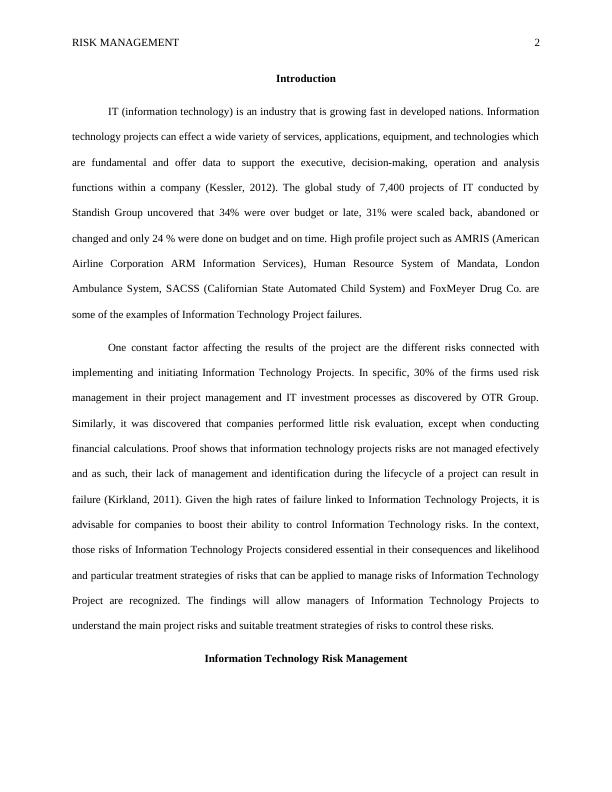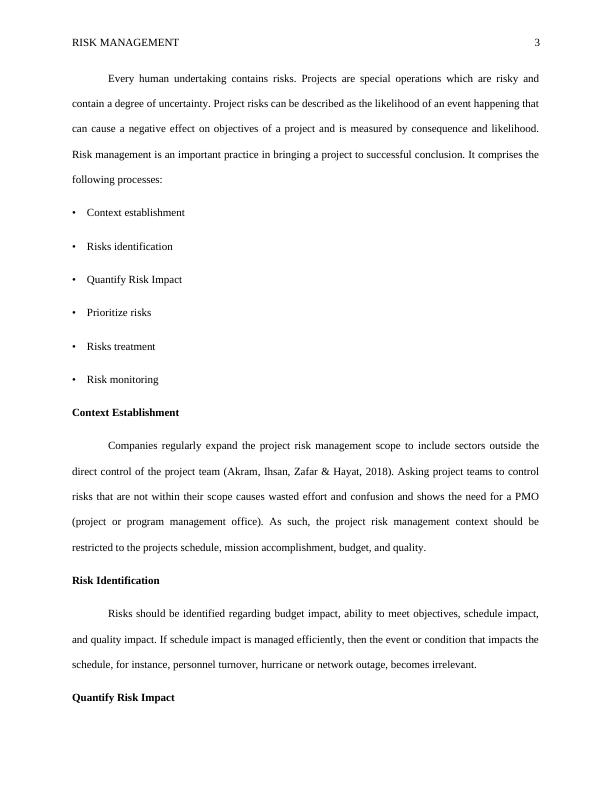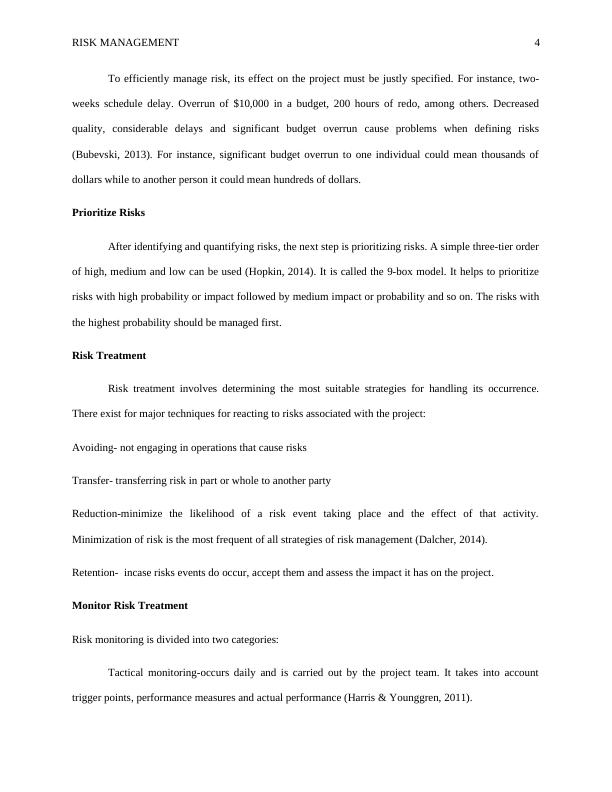Risk Management : Assignment Sample
11 Pages2661 Words42 Views
Added on 2021-06-14
Risk Management : Assignment Sample
Added on 2021-06-14
ShareRelated Documents
Running head: RISK MANAGEMENT 1Risk ManagementNameInstitutional Affiliation

RISK MANAGEMENT 2IntroductionIT (information technology) is an industry that is growing fast in developed nations. Informationtechnology projects can effect a wide variety of services, applications, equipment, and technologies whichare fundamental and offer data to support the executive, decision-making, operation and analysisfunctions within a company (Kessler, 2012). The global study of 7,400 projects of IT conducted byStandish Group uncovered that 34% were over budget or late, 31% were scaled back, abandoned orchanged and only 24 % were done on budget and on time. High profile project such as AMRIS (AmericanAirline Corporation ARM Information Services), Human Resource System of Mandata, LondonAmbulance System, SACSS (Californian State Automated Child System) and FoxMeyer Drug Co. aresome of the examples of Information Technology Project failures. One constant factor affecting the results of the project are the different risks connected withimplementing and initiating Information Technology Projects. In specific, 30% of the firms used riskmanagement in their project management and IT investment processes as discovered by OTR Group.Similarly, it was discovered that companies performed little risk evaluation, except when conductingfinancial calculations. Proof shows that information technology projects risks are not managed efectivelyand as such, their lack of management and identification during the lifecycle of a project can result infailure (Kirkland, 2011). Given the high rates of failure linked to Information Technology Projects, it isadvisable for companies to boost their ability to control Information Technology risks. In the context,those risks of Information Technology Projects considered essential in their consequences and likelihoodand particular treatment strategies of risks that can be applied to manage risks of Information TechnologyProject are recognized. The findings will allow managers of Information Technology Projects tounderstand the main project risks and suitable treatment strategies of risks to control these risks.Information Technology Risk Management

RISK MANAGEMENT 3Every human undertaking contains risks. Projects are special operations which are risky andcontain a degree of uncertainty. Project risks can be described as the likelihood of an event happening thatcan cause a negative effect on objectives of a project and is measured by consequence and likelihood.Risk management is an important practice in bringing a project to successful conclusion. It comprises thefollowing processes:• Context establishment• Risks identification• Quantify Risk Impact• Prioritize risks• Risks treatment• Risk monitoringContext EstablishmentCompanies regularly expand the project risk management scope to include sectors outside thedirect control of the project team (Akram, Ihsan, Zafar & Hayat, 2018). Asking project teams to controlrisks that are not within their scope causes wasted effort and confusion and shows the need for a PMO(project or program management office). As such, the project risk management context should berestricted to the projects schedule, mission accomplishment, budget, and quality.Risk IdentificationRisks should be identified regarding budget impact, ability to meet objectives, schedule impact,and quality impact. If schedule impact is managed efficiently, then the event or condition that impacts theschedule, for instance, personnel turnover, hurricane or network outage, becomes irrelevant.Quantify Risk Impact

RISK MANAGEMENT 4To efficiently manage risk, its effect on the project must be justly specified. For instance, two-weeks schedule delay. Overrun of $10,000 in a budget, 200 hours of redo, among others. Decreasedquality, considerable delays and significant budget overrun cause problems when defining risks(Bubevski, 2013). For instance, significant budget overrun to one individual could mean thousands ofdollars while to another person it could mean hundreds of dollars.Prioritize RisksAfter identifying and quantifying risks, the next step is prioritizing risks. A simple three-tier orderof high, medium and low can be used (Hopkin, 2014). It is called the 9-box model. It helps to prioritizerisks with high probability or impact followed by medium impact or probability and so on. The risks withthe highest probability should be managed first.Risk TreatmentRisk treatment involves determining the most suitable strategies for handling its occurrence.There exist for major techniques for reacting to risks associated with the project:Avoiding- not engaging in operations that cause risksTransfer- transferring risk in part or whole to another partyReduction-minimize the likelihood of a risk event taking place and the effect of that activity.Minimization of risk is the most frequent of all strategies of risk management (Dalcher, 2014).Retention- incase risks events do occur, accept them and assess the impact it has on the project. Monitor Risk TreatmentRisk monitoring is divided into two categories:Tactical monitoring-occurs daily and is carried out by the project team. It takes into accounttrigger points, performance measures and actual performance (Harris & Younggren, 2011).

End of preview
Want to access all the pages? Upload your documents or become a member.
Related Documents
Risk Management for Development of E-commerce Portallg...
|22
|3797
|211
Risk Management Planlg...
|8
|991
|275
Project Management Risk Management Quizlg...
|4
|977
|391
Assignment on Project Management3lg...
|27
|5504
|23
Risk Assessment Template.lg...
|1
|419
|55
Risk Register on Network System Developmentlg...
|7
|900
|55
